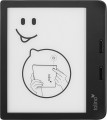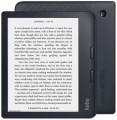E-book formats
File formats supported by the reader that contain text (and sometimes graphic information). The most popular in the CIS are, in particular,
FB2,
TXT,
HTML,
WORD (DOC),
RTF,
ePUB,
Djvu and
PDF.
Photo/video formats
File formats supported by the reader that contain multimedia information — graphics or video. The most popular image file formats are, among others,
JPG(the standard format for modern digital photography), BMP and GIF; video files —
MP4, MPG,
AVI, 3GP (video format for mobile devices),
FLV, MOV.
Operating system
A software product that ensures the correct operation of the installed software and convenient management of e-book functions. Conventionally, the family of "readers" is divided into two large camps: some work under the Android OS (in various versions of
Android 6.0,
Android 9.0,
Android 10,
Android 11,
Android 12), others run Linux. The Android system is not always well adapted to the features of the e-book interface, but a significant trump card up its sleeve is support for installing applications from the Google store.
Linux -led readers stay afloat longer in offline mode, but most of them cannot be installed with third-party applications.
CPU speed
The frequency of the built-in e-book processor is one of the main indicators that determine its performance (the speed of copying files to the built-in memory, opening larger files, loading Internet pages, etc.). On the other hand, this indicator is not decisive and can only be used for comparison in books of the same model range.
Storage capacity
The amount of the reader's own built-in memory, i.e. the memory used for persistent data storage. The more memory, the more content can be stored at a time in the e-book. At the same time, note that even the largest text (TXT, FB2, HTML) files, usually, rarely exceed 2 – 3 MB, so relatively little memory is needed for storage. Graphic and audio files, in turn, are more voluminous, but most of the space is needed for video files. Therefore, depending on the use of the gadget, you will need a different volume, whether it be
4 GB, 8 GB or more. Many readers support the ability to expand their own memory through removable cards (see
Memory card slot).
Data transfer
—
3G module. Wireless communication module based on third generation mobile networks (3G). According to the standard procedure, to connect to the 3G network, you need to purchase a SIM card. However, some Amazon Kindle models provide users with free 3G Internet access right after the first turn on.
—
Wi-Fi. A wireless communication module that allows you to connect the reader to wireless local (home or office) networks, as well as access the Internet through public access points (hot spots) installed in restaurants, hotels, railway stations, etc.
—
Bluetooth. Direct wireless communication technology between various electronic devices. In e-readers, Bluetooth is primarily used for file transfer: with this function, you can connect the reader to another Bluetooth device, such as a laptop or tablet PC, and exchange files with it.
— microUSB. Connector for direct connection of the reader to the USB port of the computer using a special cable. In e-books, this connection is used primarily for file sharing. MicroUSB is a universal standard that allows you to connect various gadgets through it with one cable.
— miniUSB. Similar to the one described above, the connector, which differs only in the size and shape of the connector.
—
USB-C. Symmetrical USB connector, which is gaining popularity and
...in the future is able to displace microUSB. At the same time, the connector has a high data transfer rate and is only a little larger in size.Multimedia
—
QWERTY keyboard. The presence in the reader of its own physical keyboard for entering text. You may need to enter text if you need to find a book by title, a piece of text by a keyword, or a word in a dictionary (see
Built-in Dictionary); this function is also useful if the reader is equipped with its own built-in browser (see Built-in browser) and is capable of providing Internet access.
—
Headphone output(3.5 mm). A standard mini-jack connector that allows you to connect headphones to an audiobook. Most consumer-grade headphones currently being produced are equipped with a 3.5 mm plug, which makes this connector very versatile. Usually, the presence of a headphone output in an audiobook means that it is equipped with a built-in media player and/or
FM tuner, and headphones can also be used to read text from the screen.
—
Dictaphone. The ability to use an e-book as a voice recorder, to record speech and other sounds. To do this, the device is equipped with its own built-in microphone, and to play the recorded material, an output to headphones and/or its own speaker is provided.
—
Built-in speaker. The audiobook has its own built-in speaker. The speaker can be used to play audio files, FM broadcasts, video soundtrack, or read text from the scree
...n; the presence of a speaker, usually, implies the presence in the reader of at least one of the above functions.
— Built-in dictionary. The presence in the software set of the book of an electronic dictionary (or several dictionaries), which allows the translation of individual words and expressions. This feature can be especially useful for those who like to read books in foreign languages.
— Built-in browser. The presence of a built-in browser allows you to view Internet pages on the screen of the reader; connection to the Internet is carried out using Wi-Fi or 3G technology (see the relevant paragraphs of the glossary)
— Built-in audio player. The ability to use an e-book to play audio files through headphones or a built-in speaker. The most common support for MP3 music files; some models are capable of playing other types of audio files, such as WMA, AAC, OGG, and even the lossless APE and FLAC formats.
— FM receiver. Readers equipped with an FM receiver allow you to listen to FM radio broadcasts through headphones or a built-in speaker.
— Voice reading. The ability of an e-book to read the written text and output it to external speakers or connected headphones. The voice sounds quite monotonous and with a noticeable "computer" accent. Pronunciation, usually, is at a level sufficient for understanding.
— Accelerometer. A device that reacts to shaking and changes in the position of an e-book in space. The accelerometer provides advanced control options: for example, you can change the screen orientation from portrait to landscape and vice versa by simply turning the reader to the appropriate position, switch the music track by shaking, etc.
